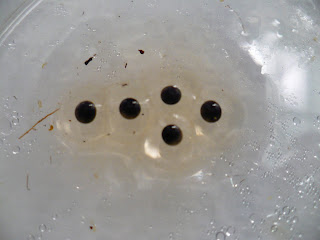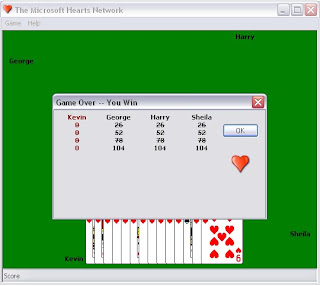
Tadpole update
My bullfrog tadpole has been doing very well since I removed him from his cold pond. I keep him in a warm greenhouse, which has rapidly increased his rate of growth. As of yesterday he had two well-formed back legs and could kick and swim. I came in today and noticed he popped his front legs out! Now he just needs to lose the tail and grow a bigger mouth to become a legitimate frog.

Rana catesbeiana
Tonight I caught not only this big guy:

American bullfrog
But also a big fat tadpole swimming in the shallows:

Bullfrogs breed in June & July so the tadpole is either 8 or 20 months old. Note how the color patterns are similar in the adult and larva, especially on the ventral surface (stomach).
I was too soft-hearted to do anything to the frog, but the tadpole has been removed from its pond in Vancouver (in case you didn't know, most people believe this invasive species is partially to blame for the decline in native amphibian populations due to predation, competition for food, and spreading of disease). It is illegal to transport this species in the state of Washington so I am definitely not taking this guy back up to Seattle with me to raise in the greenhouse.
Eggs & Tadpoles
Eventually I'd like to take a series of pictures documenting the development of frog eggs for my project data. Here are a few shots:
 Eggs (Day 2) The black spheres are the actual living tissue, contained within yellowish jelly. They are the size of BBs.
Eggs (Day 2) The black spheres are the actual living tissue, contained within yellowish jelly. They are the size of BBs.
 Eggs (Day 6) This is a different clutch. Note that the head and tail ends can be distinguished, and the jelly has lost its yellowish tint.
Eggs (Day 6) This is a different clutch. Note that the head and tail ends can be distinguished, and the jelly has lost its yellowish tint.
 Eggs (Day 2) The black spheres are the actual living tissue, contained within yellowish jelly. They are the size of BBs.
Eggs (Day 2) The black spheres are the actual living tissue, contained within yellowish jelly. They are the size of BBs. Eggs (Day 6) This is a different clutch. Note that the head and tail ends can be distinguished, and the jelly has lost its yellowish tint.
Eggs (Day 6) This is a different clutch. Note that the head and tail ends can be distinguished, and the jelly has lost its yellowish tint.
New frog
Pacific NW Scuba Diving
Here are some of the cool critters I got to enjoy this weekend (not these exact ones, I didn't have an underwater camera). Yes, it was cold- but definitely worth it.
Diamondback Nudibranch (Tritonia festiva)
Giant Pacific Octopus (Enteroctopus dofleini)

Wolf eel (Anarrhichthys ocellatus)
Moon jelly (Aurelia aurita)
Dungeoness crab (Metacarcinus magister)
Sun star (Pycnopodia helianthoides)
Ling cod (Ophiodon elongatus)
Plumose anemone (Metridium giganteum)
Pacific sanddab (Citharichthys sordidus)
Per Amy's suggestion-
I did four 20 minute dives to 40-60 feet; the water was about 45F. We dove off a beach at Mukilteo, which is about half an hour north of Seattle. It's hard to imagine when you are staring out at the water, but underneath it all is a huge sprawling underwater slope that is astonishingly abundant in marine life! Multiple species of starfish, anemones, shrimp, and crabs are always within sight crawling along the sand. The animals I was most excited to see were the eel, the nudibranch, and of course the octopus!
Diamondback Nudibranch (Tritonia festiva)

Giant Pacific Octopus (Enteroctopus dofleini)

Wolf eel (Anarrhichthys ocellatus)

Moon jelly (Aurelia aurita)

Dungeoness crab (Metacarcinus magister)

Sun star (Pycnopodia helianthoides)

Ling cod (Ophiodon elongatus)

Plumose anemone (Metridium giganteum)

Pacific sanddab (Citharichthys sordidus)

Per Amy's suggestion-
I did four 20 minute dives to 40-60 feet; the water was about 45F. We dove off a beach at Mukilteo, which is about half an hour north of Seattle. It's hard to imagine when you are staring out at the water, but underneath it all is a huge sprawling underwater slope that is astonishingly abundant in marine life! Multiple species of starfish, anemones, shrimp, and crabs are always within sight crawling along the sand. The animals I was most excited to see were the eel, the nudibranch, and of course the octopus!


